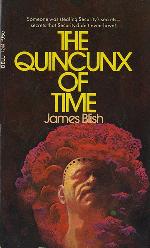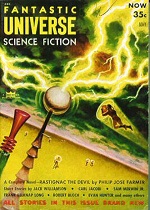|  
 
 | | | | 

| | The Haertel Scholium Stories
by James Blish
First story: Galaxy, Feb 1954

 Blish’s story “Beep” appeared in 1954 with a casual mention of time-travel when a message is overheard from a future spaceship that’s following a worldline backwards through time. The main story follows video reporter Dana Lje who stumbles upon the newly invented Dirac radio which allows instantaneous communication and, as only she realizes, also carries a record of every transmission ever made, both past and future. Blish’s story “Beep” appeared in 1954 with a casual mention of time-travel when a message is overheard from a future spaceship that’s following a worldline backwards through time. The main story follows video reporter Dana Lje who stumbles upon the newly invented Dirac radio which allows instantaneous communication and, as only she realizes, also carries a record of every transmission ever made, both past and future.

At Larry Shaw’s request, Blish expanded “Beep” into the short novel The Quincunx of Time, and both these stories share a background wherein the work of Dolph Haertel (the next Einstein) provides an ftl-drive (the Haertel Overdrive, later called the Imaginary Drive), an antigravity device (the spindizzy), and an instantaneous communicator (the Dirac Radio). I read many of these in the early ’70s, but can’t find my notes and don’t remember any other time travel beyond that one communiqué that Lje overheard. Still, I’ll list everything in The Haertel Scholium and reread them some day!- Pantropy and Seedling Stars stories (1942-1956) Various publications
- Cities in Flight stories (1952-1962) Various publications
- Common Time (Jul 1953) in Shadow of Tomorrow
- Beep (Feb 1954) Galaxy
- Nor Iron Bars (Nov 1957) Infinity
- A Case of Conscience (Sep 1953) & novel (1958) If
- A Dusk of Idols (Mar 1961) Amazing
- Midsummer Century (Apr 1972) & novel (May 1972) F&SF
- The Quincunx of Time (Oct 1973) expands “Beep”
 It is instead one of the seven or eight great philosophical questions that remain unanswered, the problem of whether man has or has not free will. It is instead one of the seven or eight great philosophical questions that remain unanswered, the problem of whether man has or has not free will. 
| |
| | | | |

 
 
 
 
 | | | | 

| | “Where the World is Quiet”
by Henry Kuttner (as by C.H. Liddell)
First publication: Fantastic Universe, May 1954

This story appears in an issue of Fantastic Universe with a remarkable lineup including Frank Belknap Long, Philip José Farmer, Jack Williamson, Philip K. Dick, Richard Matheson, Marion Zimmer Bradley, and Robert Bloch. As for Kuttner’s contribution, a crippled priest enlists the aid of an adventurous anthropologist, Señor White, to track the fate of seven young girls who disappeared into the Cordilleras of eastern Peru in the direction of the great peak, Hauscan. Do anthropologists know anything about time-slips? (Yes, just a slight time-travel connection.) So, even now I do not know all that lay behind the terror in that Peruvian valley. This much I learned: the Other, like Lhar and her robot, had been cast adrift by a time-slip, and thus marooned here. There was no way for it to return to its normal Time-sector. It had created the fog-wall to protect itself from the direct rays of the sun, which threatened its existence. So, even now I do not know all that lay behind the terror in that Peruvian valley. This much I learned: the Other, like Lhar and her robot, had been cast adrift by a time-slip, and thus marooned here. There was no way for it to return to its normal Time-sector. It had created the fog-wall to protect itself from the direct rays of the sun, which threatened its existence. 
| |
| | | | |

 
 
 
 
 
 
 
 
No Time Travel. Move along. |
“Lost in the Future” by John Victor Peterson, Fantastic Universe, Jan 1954 [continually viewing the past ]

“Time Fuze” by Randall Garrett, If, Mar 1954 [FTL ]

“The Golden Man” by Philip K. Dick, If, Apr 1954 [visions of possible futures ]

| |     |